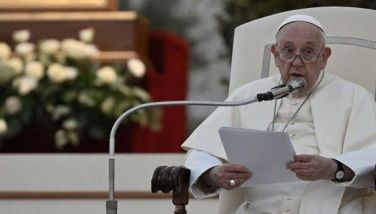Israeli library's manuscripts tell unique stories
JERUSALEM — These are treasures that Israel doesn't allow anyone to check out of its national library.
Kafka's Hebrew vocabulary notebook. The first written evidence of the Yiddish language. And the Crowns of Damascus, Bibles smuggled out of Syria 20 years ago in a Mossad spy operation so classified that their very existence in Israel was kept secret for years.
Many nations maintain official libraries of their countries' most prized historical manuscripts. Israel's is unique: It seeks manuscripts from every country in the world where Jews have ever lived.
Now the National Library of Israel is dusting the cobwebs off some of the most prized jewels of its collection as it seeks to draw attention to a new effort to preserve — and publicize — these treasures.
It's pioneering a worldwide initiative to digitize every Hebrew manuscript in existence. It's building a new home next to the Israeli parliament. On Sunday, it sent a prized manuscript handwritten by medieval Jewish philosopher Maimonides to France accompanied by bodyguards for a first-ever display at the Louvre Museum.
Later this month, the library is convening what it calls a Global Forum of luminaries — philanthropist Lord Rothschild, former US diplomat Elliott Abrams, Nobel laureate Daniel Kahneman and others — to raise the profile of the collection.
This week, the library in Jerusalem opened its vaults and gave The Associated Press a rare glimpse at its most prized treasures. Some had not been made public in years. Others have never had public viewings.
"Though these items are unique, what makes them even more unique is the stories behind them," said Aviad Stollman, the library's head of collections.
Here's a look at a few of those manuscripts, and the unlikely route they took to Jerusalem.
__
THE CROWNS OF DAMASCUS
These "crowns," a Jewish term for revered biblical manuscripts, are some of the earliest complete manuscripts of the Hebrew Bible. Written in the Middle East and Europe between 700 to 1,000 years ago, they were safeguarded by Syria's ancient Jewish community in Damascus for hundreds of years.
Syria's late dictator, Hafez Assad, lifted travel restrictions on Jews in the early 1990s. Some resettled in Israel, and with them, the manuscripts, in a classified operation by Israel's Mossad espionage agency. They were deposited at the national library for restoration and climate-controlled storage.
"We got them from the Mossad on condition that we would keep it a complete secret," said Raphi Weiser, who at the time was the director of the library's manuscripts and archives director. Only a dozen staffers at the library knew about the manuscripts at the time, said Weiser, who is now retired and still volunteers at the library.
The existence of the manuscripts in Israel was made public in 2000, when they were shown to a private audience. They have not been displayed since.
The most precious of the collection, a 13th-century Spanish Bible, used to be kept at Damascus' ancient Jobar synagogue, Weiser said. Last year the synagogue was destroyed in Syria's civil war, according to opposition activists.
"You wonder what would have happened to this manuscript if it would have remained there," Weiser said.
__
KAFKA'S HEBREW NOTEBOOK
This thin notebook contains 20 pages of Hebrew vocabulary words scrawled in the large block letters of preeminent author Franz Kafka.
At the end of his life, the German-speaking Jewish author considered leaving Prague and moving to pre-state Israel. He took Hebrew lessons with an 18-year-old Jerusalem native who was in Prague in the 1920s studying math. He never moved to the emerging Jewish state, which gained independence in 1948, but his teacher eventually donated her student's vocabulary notebook to the collection.
None of Kafka's writings were supposed to have survived. Before he died, Kafka asked his friend to burn them. Instead, his works were published, turning Kafka posthumously into one of the most celebrated writers of the 20th century.
In a Kafkaesque courtroom saga, an Israeli court in 2012 ruled that two Israeli sisters in possession of a trove of unpublished Kafka manuscripts must hand them over to the national library.
The ruling is being appealed. The library says if it receives the manuscripts, it will post them online, and unknown stories by Kafka may emerge.
__
NEWTON'S THEOLOGICAL THEORIES
Sir Isaac Newton gave the world three laws of motion that bear his name. But he had other theories too: about Hebrew scripture and the apocalypse.
In his cursive English, occasionally laced with Hebrew words, Newton applied his scientific mind to measurements of the ancient Jewish Temple in Jerusalem and predicted the end of the world in the year 2060.
These writings should have ended up at Cambridge University, where his descendants donated most of Newton's original manuscripts in 1872. But at the time, Cambridge expressed no interest in Newton's theological scribbles, said Milka Levy-Rubin, curator of the Israel national library's humanities collection.
In 1936, his descendants sold the manuscripts at Sotheby's auction house. But bidders were far more interested in an auction of impressionist paintings at London's rival auction house Christie's the very same day.
Jewish scholar Abraham Shalom Yahuda caught wind of the manuscripts, bought the theological writings, and donated them to what would become the national library.
__
EARLIEST YIDDISH TEXT
This enormous, heavy 13th-century prayer book, written in red and black Hebrew calligraphy, was used by cantors to lead festival prayers in the synagogue of Worms, a German city.
On page 54a, buried inside the large black Hebrew letters of a Passover hymn, is a message: "Let a good day shine for him who carries this prayer book to the synagogue."
It's the earliest known textual evidence of Yiddish, the centuries-old language of Ashkenazi Jews of central and eastern Europe.
The prayer book was in use until the synagogue was destroyed in 1938 on Kristallnacht, a night of attacks on Jewish properties in Nazi Germany. The city's archivist managed to ferret the manuscript's two volumes out of a Gestapo office basement and hid it in the tower of the city's cathedral, saving it from the Allied bombing of the city.
In 1957, as part of Holocaust reparation negotiations, Germany gave Israel the historical prayer book.
__
NOBEL LAUREATE'S SCRAPS
Israel's only winner of the Nobel Prize for Literature, S.Y. Agnon, was writing his masterpiece "Shira" when, as he often did, he ripped up drafts of the work in his quest for perfection. But at some point, he became too ill to climb the stairs and burn the drafts in his fireplace.
His son managed to collect the torn scraps of paper from Agnon's fireplace and wastebasket, and upon the author's death in 1970, his family donated them and manuscripts of his novel to Israel's National Library, said Weiser.
The drafts and handwritten manuscripts reveal Agnon's obsessive editing and re-editing, like names of main characters that changed, wordings reworked.
"If he would have put that energy into new stories," Weiser said, "We could have enjoyed many more volumes of works."
- Latest
- Trending
































